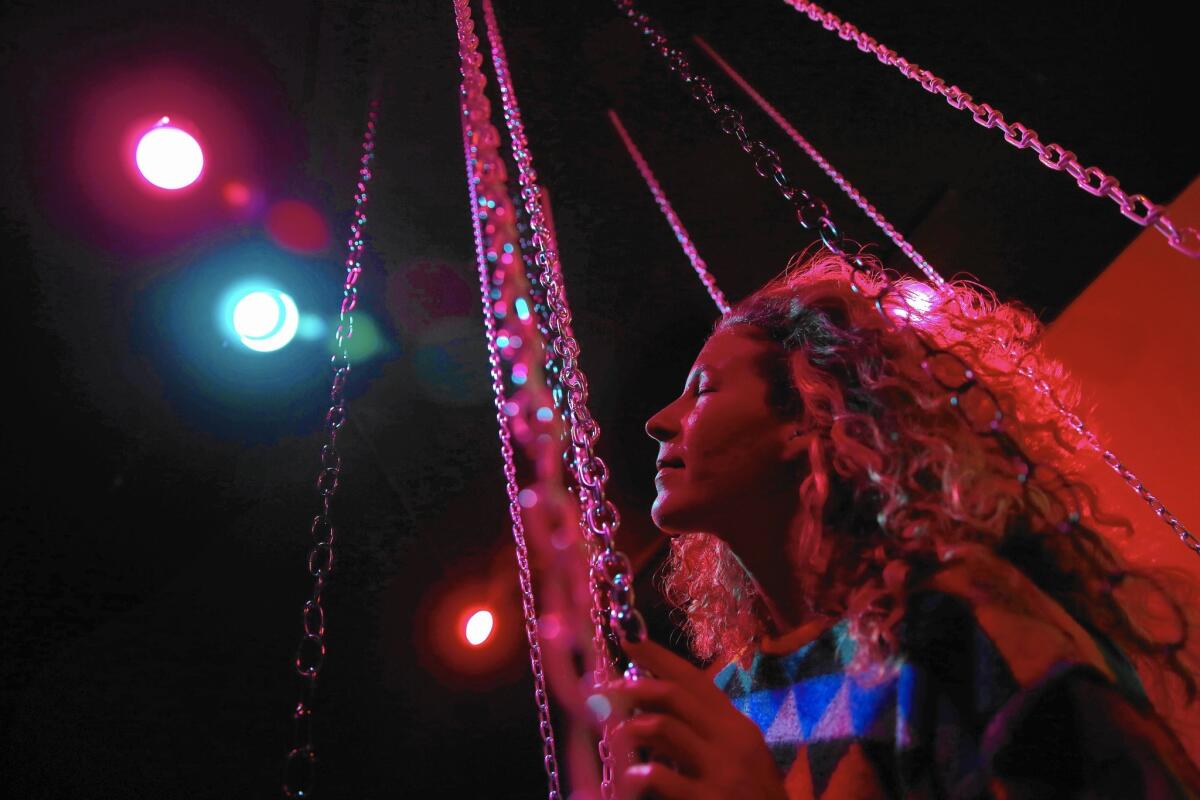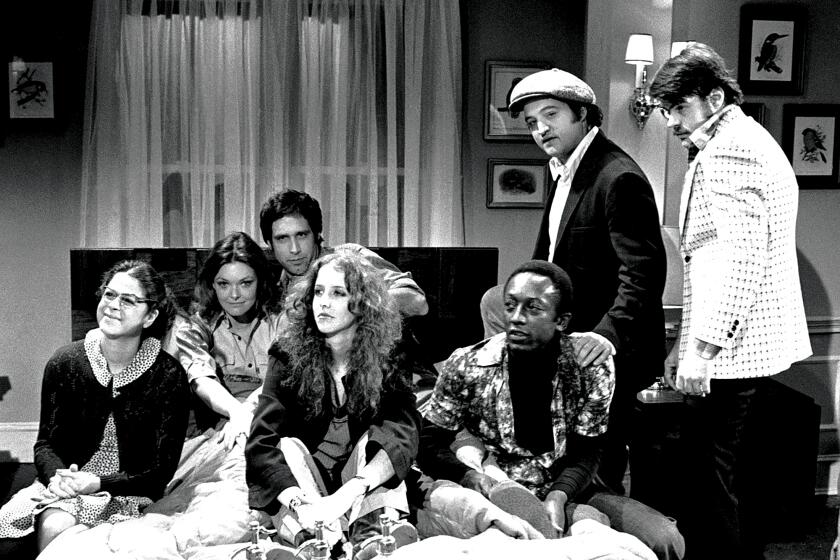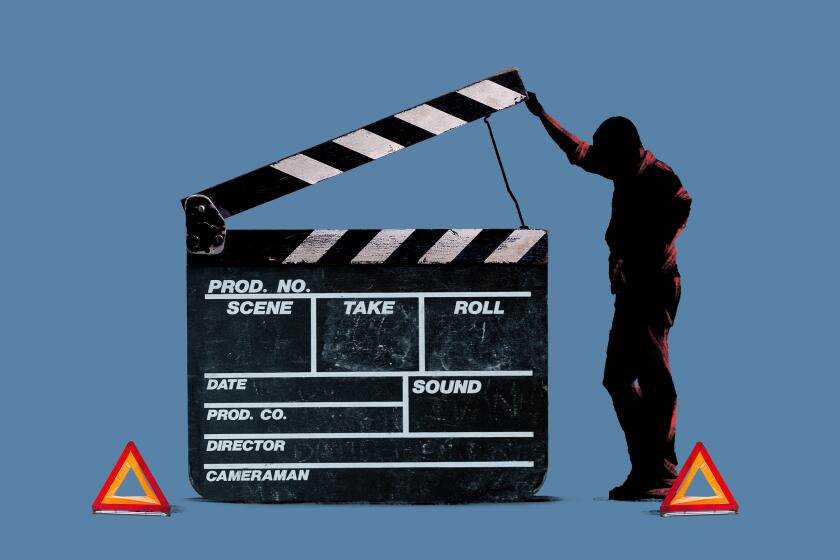Julie Weitz’s ‘Touch Museum’ tweaks time and space

- Share via
Warning: Upon entering Julie Weitz’s “Touch Museum,” a multi-screen video installation at Young Projects in the Pacific Design Center, artgoers may experience bouts of lightheartedness and calm; a sense of euphoria, even. Participants might get giddy. Tingly. Nauseous, perhaps. Or extra-alert.
The seven-room video art series is inspired by a condition some people call Autonomous Sensory Meridian Response, in which certain visual, auditory or cognitive stimuli such as soft whispering, paintbrush swooshing or paper shuffling prompts pleasurable tingling — a “head orgasm,” as it’s often described by those who experience it.
Weitz’s videos juxtapose the physical, textural experience of living with the more remote digital universe in which we’re so often immersed. As the installation progresses, the videos become more rooted in the ASMR world while still offering a more universal commentary on sensuality.
SIGN UP for the free Classic Hollywood newsletter >>
Sparking the senses through digitization might seem like a contradiction, but there’s a robust ASMR community online built largely around YouTube videos meant to trigger a sense of euphoria and relaxation. One video shows the repeated brushing of hair; another, rhythmic fingernail tapping. Weitz has her own YouTube channel of ASMR videos, including one in which the artist shines flashlights into the camera lens while whispering text from the French philosopher Emmanuel Levinas.
Weitz, a painter who taught at the University of South Florida for eight years, began experimenting with video art in 2010. She says she’s had heightened sensory perception since she was a teenager and likely has a mild version of ASMR, which is not a scientifically defined condition. Last year, while doing a residency at the Banff Centre in Montreal, Weitz met art writer Nancy Webb, who says she has ASMR and who had a powerful, visceral reaction to Weitz’s video work.
“She said it was like her brain was melting; she was getting tingling down her back,” Weitz says. “It was such a strong reaction, I thought, ‘I have to explore this.’”In an essay Webb wrote for “Touch Museum,” the writer said of one of Weitz’s videos, “I don’t hear the final word uttered — I feel it.”
The space housing “Touch Museum” is also set up to evoke a physical response — it’s somewhat trippy, as if co-conceived by Lewis Carroll and James Turrell. The floor of the entryway, the only well-lighted room in the exhibition, is lined with puffy egg-crate foam, so each footstep sinks in, buoyant, immediately altering guests’ physical orientation. Soft, new age-y music, originally composed for the exhibit by L.A.-based musician Deru, plays throughout. Viewers then embark on a dark, maze-like journey through multiple odd-shaped rooms illuminated only by the ambient glow of video screens and a few soft, multicolored ceiling lights. The video screens and projections on hanging scrims are reflected, repeatedly, around the room through a curved, mirrored wall; it’s often unclear what’s real and what’s a reflection.
The artist’s aim
“I’m definitely playing with that illusory experience of image,” Weitz says, adding that the installation as a whole is a deconstruction of digital culture through physical form.
“So much of our time is spent in the digital space and that was a space I wanted to puncture somehow,” she adds. “But I’m a material-based person, so I wanted it to be something physical, something that evoked a sensory response in the way that I respond to colors and textures and sound.”
Chains — both real and projected — appear throughout the exhibition. A cluster of them hang from the gallery’s entranceway ceiling; swinging gently, they beckon to be fondled but offer tiny electrical shocks when touched. A digital print of chain-links, a still from one of Weitz’s videos, hangs opposite it. The recurring imagery in the exhibition is both texturally beautiful and ominous at once, laden with double meaning.
“The chains stand in as a sort of metaphor for attachment or connection — links,” Weitz says. But also being stuck or trapped. There’s a sort of meditative quality to this show, though, so even when there’s moments that seem sort of destructive or violent, they’re all within this sense of calm.”
Further weaving the digital and tactile worlds, Weitz uses only practical effects, such as props and puppets, in her videos. She watched 1970s sci-fi movies to nail what she calls “an anti-CGI” aesthetic, and was inspired by Italian horror film director Dario Argento. For one large-scale video, Weitz bought dozens of kitschy, plaster Greco-Roman sculptures from a cheap craft store in New Jersey; then she tied the sculptures to chains and swung them back and forth, videoing the process of breaking them apart. Weitz then further altered the shattered heads and busts, sanding and painting them, dipping them in plaster, spraying dye on them, lighting them on fire, filling them with colored smoke.
“Classical sculpture is like an ancient version of an avatar — this idealized form of the self,” Weitz says. “I was hearkening back to this ancient idea and then seeing if I could break that apart somehow.”
For another video, Weitz dipped her own hand in porcelain slip and let it dry, creating a crackling petrifaction effect on her skin; her dusty, chalky-looking body then appeared a decaying sculpture itself.
A hands-on ‘Search’
In the video “Net Search,” Weitz’s tie-dyed hands probe and cut through a tangled web of netting. “It’s about what’s it like to move through the Internet space, searching for something,” she says. “But everything, for me, is also like archaeology, ancient artifacts.”
In this way, “Touch Museum” is also a meta-commentary on museums and art itself. The gallery space is a riff on the sometimes daunting experience of moving through a museum, and the name of the installation is more than a little ironic given touching art is off limits at most institutions. Weitz also incorporated into the gallery space, materials she worked with in creating her videos — the egg-crate foam was used for recording sound, the chains aided in breaking apart the sculptures. So it’s a museum of process as well.
“I like integrating all the different materials I’m using into the final work,” Weitz says.
In the back room, or “the cave,” as Weitz calls it, two video pieces face each other, engaging in a sort of dialogue — each depicts a shining flashlight aimed directly at the viewer — as a subwoofer sends deep, thump-thumping vibrations across the floor. The effect is heady and physical, a painterly and digital reflection of the mind-body connection.
On the way out, visitors pass through a tiny nook, snug with a mounted TV screen, two headsets and meditation pillows on the floor. The piece invites viewers to settle in and watch a video of paint dripping over the mold of a brain as Weitz whispers more French philosophy, this time from Henri Bergson.
This reporter got a tad seasick watching it. Others, Weitz says, have zoned out, relaxed, or they’ve become energized by the whispered words. Some have burst into tears.
“That’s kind of the point,” Weitz says. “The whole concept was: I’m gonna change your sense of time and space for this moment. If you’ve come all this way to the gallery, then I’m gonna give you an experience.”
Twitter: @debvankin
------------
Julie Weitz: ‘Touch Museum’
Where: Young Projects Gallery, 8687 Melrose Ave., West Hollywood
When: Through Feb. 22
Info: (323) 377-1102, www.youngprojectsgallery.com, www.julieweitz.com/touchmuseum/
More to Read
The biggest entertainment stories
Get our big stories about Hollywood, film, television, music, arts, culture and more right in your inbox as soon as they publish.
You may occasionally receive promotional content from the Los Angeles Times.











